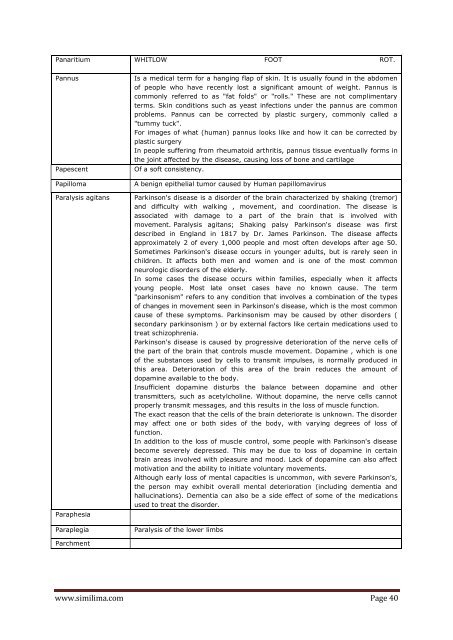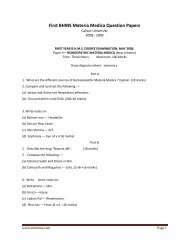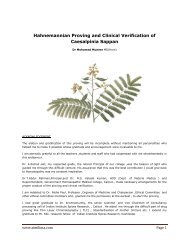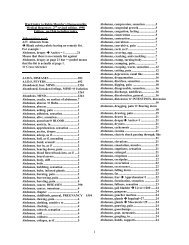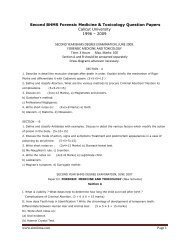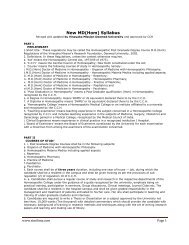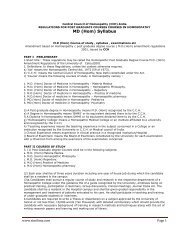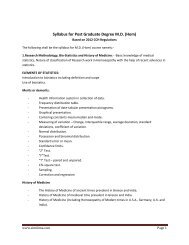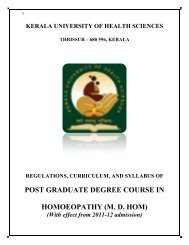Denotations & Old terminologies used in Homopathy - Similima
Denotations & Old terminologies used in Homopathy - Similima
Denotations & Old terminologies used in Homopathy - Similima
Create successful ePaper yourself
Turn your PDF publications into a flip-book with our unique Google optimized e-Paper software.
Panaritium WHITLOW FOOT ROT.<br />
Pannus Is a medical term for a hang<strong>in</strong>g flap of sk<strong>in</strong>. It is usually found <strong>in</strong> the abdomen<br />
of people who have recently lost a significant amount of weight. Pannus is<br />
commonly referred to as "fat folds" or "rolls." These are not complimentary<br />
terms. Sk<strong>in</strong> conditions such as yeast <strong>in</strong>fections under the pannus are common<br />
problems. Pannus can be corrected by plastic surgery, commonly called a<br />
"tummy tuck".<br />
For images of what (human) pannus looks like and how it can be corrected by<br />
plastic surgery<br />
In people suffer<strong>in</strong>g from rheumatoid arthritis, pannus tissue eventually forms <strong>in</strong><br />
the jo<strong>in</strong>t affected by the disease, caus<strong>in</strong>g loss of bone and cartilage<br />
Papescent Of a soft consistency.<br />
Papilloma A benign epithelial tumor ca<strong>used</strong> by Human papillomavirus<br />
Paralysis agitans Park<strong>in</strong>son's disease is a disorder of the bra<strong>in</strong> characterized by shak<strong>in</strong>g (tremor)<br />
and difficulty with walk<strong>in</strong>g , movement, and coord<strong>in</strong>ation. The disease is<br />
associated with damage to a part of the bra<strong>in</strong> that is <strong>in</strong>volved with<br />
movement. Paralysis agitans; Shak<strong>in</strong>g palsy Park<strong>in</strong>son's disease was first<br />
described <strong>in</strong> England <strong>in</strong> 1817 by Dr. James Park<strong>in</strong>son. The disease affects<br />
approximately 2 of every 1,000 people and most often develops after age 50.<br />
Sometimes Park<strong>in</strong>son's disease occurs <strong>in</strong> younger adults, but is rarely seen <strong>in</strong><br />
children. It affects both men and women and is one of the most common<br />
neurologic disorders of the elderly.<br />
In some cases the disease occurs with<strong>in</strong> families, especially when it affects<br />
young people. Most late onset cases have no known cause. The term<br />
"park<strong>in</strong>sonism" refers to any condition that <strong>in</strong>volves a comb<strong>in</strong>ation of the types<br />
of changes <strong>in</strong> movement seen <strong>in</strong> Park<strong>in</strong>son's disease, which is the most common<br />
cause of these symptoms. Park<strong>in</strong>sonism may be ca<strong>used</strong> by other disorders (<br />
secondary park<strong>in</strong>sonism ) or by external factors like certa<strong>in</strong> medications <strong>used</strong> to<br />
treat schizophrenia.<br />
Park<strong>in</strong>son's disease is ca<strong>used</strong> by progressive deterioration of the nerve cells of<br />
the part of the bra<strong>in</strong> that controls muscle movement. Dopam<strong>in</strong>e , which is one<br />
of the substances <strong>used</strong> by cells to transmit impulses, is normally produced <strong>in</strong><br />
this area. Deterioration of this area of the bra<strong>in</strong> reduces the amount of<br />
dopam<strong>in</strong>e available to the body.<br />
Insufficient dopam<strong>in</strong>e disturbs the balance between dopam<strong>in</strong>e and other<br />
transmitters, such as acetylchol<strong>in</strong>e. Without dopam<strong>in</strong>e, the nerve cells cannot<br />
properly transmit messages, and this results <strong>in</strong> the loss of muscle function.<br />
The exact reason that the cells of the bra<strong>in</strong> deteriorate is unknown. The disorder<br />
may affect one or both sides of the body, with vary<strong>in</strong>g degrees of loss of<br />
function.<br />
In addition to the loss of muscle control, some people with Park<strong>in</strong>son's disease<br />
become severely depressed. This may be due to loss of dopam<strong>in</strong>e <strong>in</strong> certa<strong>in</strong><br />
bra<strong>in</strong> areas <strong>in</strong>volved with pleasure and mood. Lack of dopam<strong>in</strong>e can also affect<br />
motivation and the ability to <strong>in</strong>itiate voluntary movements.<br />
Although early loss of mental capacities is uncommon, with severe Park<strong>in</strong>son's,<br />
the person may exhibit overall mental deterioration (<strong>in</strong>clud<strong>in</strong>g dementia and<br />
halluc<strong>in</strong>ations). Dementia can also be a side effect of some of the medications<br />
<strong>used</strong> to treat the disorder.<br />
Paraphesia<br />
Paraplegia Paralysis of the lower limbs<br />
Parchment<br />
www.similima.com Page 40


